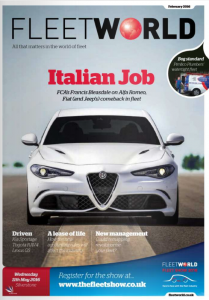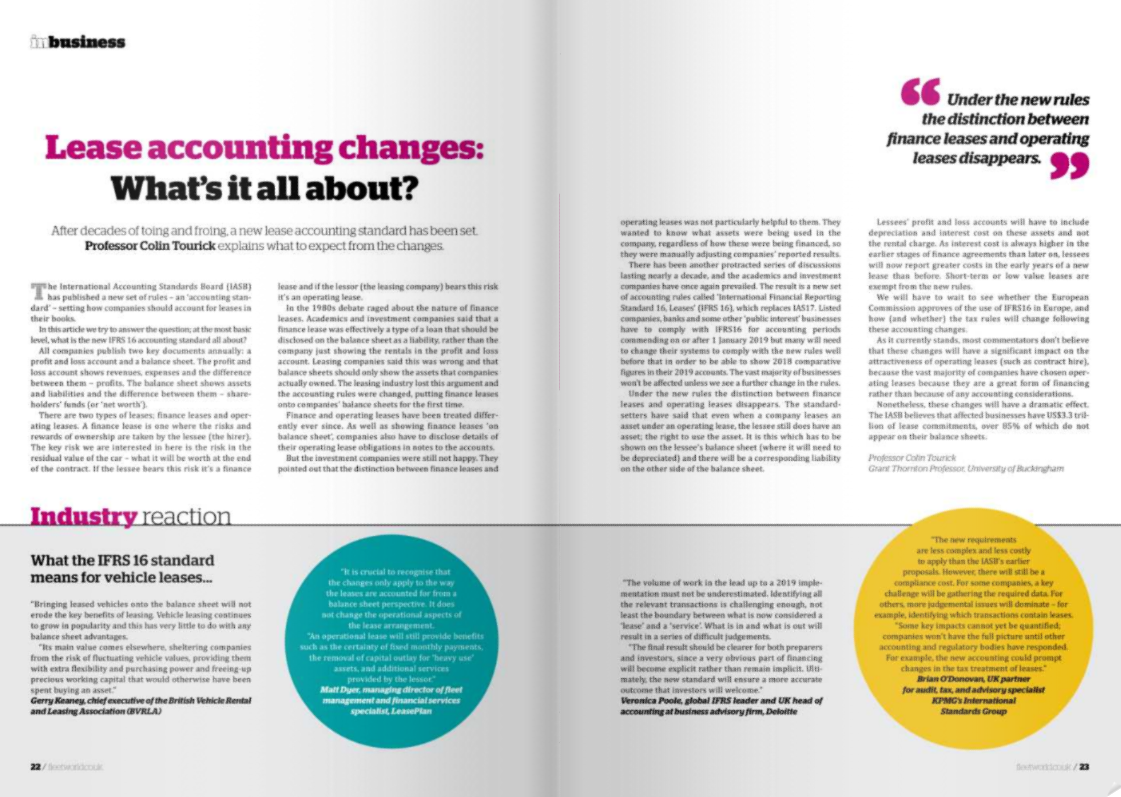Article published in Fleet World
Tax isn’t the most fascinating of subjects for most people. However, as a fleet manager a knowledge of tax is unavoidable because every decision you make – including whether you offer company cars or a cash allowance, which cars to put on your fleet, how to finance them, how to pay for maintenance costs, etc – has a tax consequence.
In this article we will look at two taxes that are about to increase sharply and discuss ways you might reduce these.
The first tax is vehicle excise duty. The system is due change from 1 April and there is still time (just) for you to take steps to make some savings.
This chart shows the old and the new VED rates:
| Cars registered before 1 April 2017 | Cars registered on or after 1 April 2017 | |||||
| CO2 emissions
g/km |
First year rate | Standard rate | CO2 emissions (g/km) | First year rate | Standard rate for petrol or diesel*
|
|
| Petrol and diesel | Alternative fuel cars# | |||||
| Up to 100 | £0.00 | £0.00 | 0 | £0 | £0 | £0 |
| 1-50 | £10 | £0 | £140 | |||
| 51-75 | £25 | £15 | £140 | |||
| 76-90 | £100 | £90 | £140 | |||
| 91-100 | £120 | £110 | £140 | |||
| 101-110 | £0.00 | £20.00 | 101-110 | £140 | £130 | £140 |
| 111-120 | £0.00 | £30.00 | 110 -130 | £160 | £150 | £140 |
| 121-130 | £0.00 | £110.00 | ||||
| 131-140 | £130.00 | £130.00 | 131-150 | £200 | £190 | £140 |
| 141-150 | £145.00 | £145.00 | ||||
| 151-165 | £185.00 | £185.00 | 151-170 | £500 | £490 | £140 |
| 166-175 | £300.00 | £210.00 | ||||
| 176-185 | £355.00 | £230.00 | 171-190 | £800 | £790 | £140 |
| 186-200 | £500.00 | £270.00 | ||||
| 201-225 | £650.00 | £295.00 | 191-225 | £1200 | £1190 | £140 |
| 226-255 | £885.00 | £500.00 | 226-255 | £1700 | £1690 | £140 |
| Over 255 | £1,120.00 | £515.00 | Over 255 | £2000 | £1990 | £140 |
*£10 discount for non-electric cars emitting any CO2
#Alternative fuel includes hybrids, bio-ethanol and LPG
There is an additional £310 payable for five years after the first 12 months for cars costing over £40,000 that were first registered on or after 1 April 2017.
| Fuel | Standard annual rate | Additional rate | Total annual payment |
| Electric | £0 | £310 | £310 |
| Alternative | £130 | £310 | £440 |
| Petrol or diesel | £140 | £310 | £450 |
After 5 years, the standard annual rate is payable, depending on which fuel the vehicle uses.
We now have a system that is more complicated than before. The first thing to notice is that VED is now going to be payable for the first time on cars emitting less than 101g/km of CO2. Quite a lot of VED, in fact: £680 over four years for a diesel car emitting 91-100g/km (first year rate plus standard rate). You can add another £930 to that if the list price exceeds £40,000. This will annoy fleet managers who made a conscious effort to move their employees into low emission cars.
According to the Department of Transport, the national average emission level for all new cars is 120.8g/km.
The latest BVRLA figures show that new cars added to their members’ fleets in Q4 2016 emitted an average of 110.9g/km. This falls by about 2g/km each year, so we can deduce that the average fleet car will probably be emitting just below 110g/km very soon. VED is currently £20 per pa for those cars or £80 over a four year life, but for cars registered from 1 April that £80 will become a whopping £700 (£1,630 if they cost over £40,000). That’s a hefty increase that won’t have been accounted for in most fleet managers’ budgets.
There is a very small window of opportunity left for you to save that extra amount – order new cars now and have them registered before 1 April. In fact, if you can get any new sub-120g/km car on the road before 1 April you’ll save hundreds of pounds in VED.
The other way you can save VED for a short while after 1 April is by buying (or leasing) a nearly new car, because it’s the vehicle registration date that determines the VED treatment rather than the date you take it onto your fleet. There are always lots of pre-registered cars in the market. Now might be the time to ask your dealer or leasing company if they can get hold of one for you. The lease rental will be quite a bit lower too.
The other tax to be aware of at the moment is benefit in kind (BIK) tax on company cars.
The general rule is that BIK tax is calculated by multiplying the list price of the car by the employee’s marginal tax rate and the ‘appropriate percentage’ shown in this chart.
APPROPRIATE PERCENTAGES FOR CAR BENEFIT CALCULATIONS
| 2016-17 | 2017-18 | 2018-19 | 2019-20 | ||||
| CO2
emissions |
CO2
emissions |
CO2
emissions |
CO2
emissions |
||||
|
0-50 |
7% |
0-50 |
9% |
0-50 |
13% |
0-50 |
16% |
| 51-75 | 11% | 51-75 | 13% | 51-75 | 16% | 51-75 | 19% |
|
76-94 |
15% |
76-94 |
17% |
76-94 |
19% |
76-94 |
22% |
| 95-99 | 16% | 95-99 | 18% | 95-99 | 20% | 95-99 | 23% |
| 100-104 | 17% | 100-104 | 19% | 100-104 | 21% | 100-104 | 24% |
| 105-109 | 18% | 105-109 | 20% | 105-109 | 22% | 105-109 | 25% |
| 110-114 | 19% | 110-114 | 21% | 110-114 | 23% | 110-114 | 26% |
| 115-119 | 20% | 115-119 | 22% | 115-119 | 24% | 115-119 | 27% |
| 120-124 | 21% | 120-124 | 23% | 120-124 | 25% | 120-124 | 28% |
| 125-129 | 22% | 125-129 | 24% | 125-129 | 26% | 125-129 | 29% |
|
130-134 |
23% |
130-134 |
25% |
130-134 |
27% |
130-134 |
30% |
| 135-139 | 24% | 135-139 | 26% | 135-139 | 28% | 135-139 | 31% |
| 140-144 | 25% | 140-144 | 27% | 140-144 | 29% | 140-144 | 32% |
| 145-149 | 26% | 145-149 | 28% | 145-149 | 30% | 145-149 | 33% |
| 150-154 | 27% | 150-154 | 29% | 150-154 | 31% | 150-154 | 34% |
| 155-159 | 28% | 155-159 | 30% | 155-159 | 32% | 155-159 | 35% |
| 160-164 | 29% | 160-164 | 31% | 160-164 | 33% | 160-164 | 36% |
| 165-169 | 30% | 165-169 | 32% | 165-169 | 34% | 165 and above | 37% |
| 170-174 | 31% | 170-174 | 33% | 170-174 | 35% | ||
| 175-179 | 32% | 175-179 | 34% | 175-179 | 36% | ||
| 180-184 | 33% | 180-184 | 35% | 180 and above | 37% | ||
| 185-189 | 34% | 185-189 | 36% |
Add 3% for diesel cars, up to a maximum of 37% in total.
|
|||
| 190-194 | 35% | 190 & above | 37% | ||||
| 195-199 | 36% | ||||||
| 200 and above | 37% | ||||||
The appropriate percentages will rise substantially over the next few years, particularly for drivers of lower-emission cars. Whilst the actual tax paid by these employees will still be relatively low, the annual percentage increases will be high. So, for example, an employee currently driving a car emitting 99g/km will see their appropriate percentage rise from 16% to 23% in just over three years’ time, a whopping 43.75% more than they are paying today.
So what can you do when these employees start grumbling about this steep increase?
One option would be to see whether there are cars that emit lower levels of CO2 that might be suitable to put onto your fleet list.
Another interesting option would be to check to see whether there are savings to be made from encouraging employees to lease their own vehicles direct from your leasing company using a personal contract hire agreement. You would pay them a cash allowance and they could claim for business mileage at the HMRC approved rates. It is important – really important – that you don’t let this become a free-for-all with employees going off and doing their own thing, because very soon you’d find yourself doing more work to ensure that these cars are being taxed, insured and serviced on time.
Yet another option would be to look at setting up an Employee Car Ownership Scheme (ECOS). These have fallen out of fashion but it seems there may be a resurgence afoot, and at least one leasing company has just started offering these to relatively small fleets.
If you want the best possible solution – total control, lowest cost – you could opt for a hybrid ECOS/contract hire scheme. These represent the gold standard in cost-optimisation. They aren’t for the feint hearted but they really do tick a lot of boxes.
Every ECO scheme gets HMRC approval but there was some ambiguity around the treatment of AMAPs in the wording of the draft finance bill relating to salary sacrifice and cash allowances. This should be resolved within the next few weeks so we won’t go into details here. However, if you decide to explore changes in your funding method, make sure you get professional tax advice.
Professor Colin Tourick













